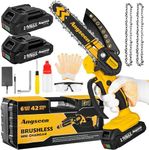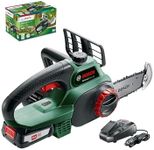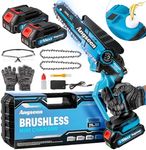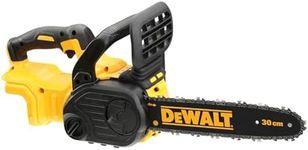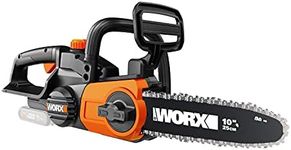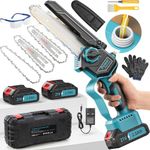Buying Guide for the Best Battery Chainsaws
Choosing the right battery chainsaw involves understanding your specific needs and matching them with the right features. Battery chainsaws are great for their portability, ease of use, and low maintenance compared to gas-powered models. However, there are several key specifications you should consider to ensure you get the best fit for your tasks. Here’s a breakdown of the most important specs and how to navigate them.Battery VoltageBattery voltage indicates the power output of the chainsaw. Higher voltage means more power, which is essential for cutting through thicker and harder wood. Battery chainsaws typically range from 18V to 80V. For light pruning and small branches, a lower voltage (18V-36V) is sufficient. For medium tasks like cutting firewood or felling small trees, a mid-range voltage (40V-60V) is ideal. For heavy-duty tasks, such as cutting large logs, opt for higher voltage (60V-80V). Choose based on the type of work you plan to do most often.
Battery Capacity (Ah)Battery capacity, measured in ampere-hours (Ah), determines how long the chainsaw can run on a single charge. Higher Ah means longer runtime. Chainsaws typically have batteries ranging from 2Ah to 8Ah. For occasional use and small jobs, a lower capacity (2Ah-4Ah) is adequate. For regular use and medium tasks, a mid-range capacity (4Ah-6Ah) is better. For extended use and heavy-duty tasks, a higher capacity (6Ah-8Ah) is recommended. Consider how long you need the chainsaw to run without recharging.
Bar LengthThe bar length determines the maximum size of the wood you can cut. Chainsaws come with bar lengths ranging from 10 inches to 18 inches. For light pruning and trimming, a shorter bar (10-12 inches) is sufficient. For cutting small to medium trees and firewood, a mid-range bar (14-16 inches) is ideal. For larger trees and heavy-duty cutting, a longer bar (16-18 inches) is necessary. Match the bar length to the size of the wood you will be cutting most frequently.
Chain SpeedChain speed, measured in feet per second (fps) or meters per second (m/s), affects how quickly and efficiently the chainsaw can cut. Higher chain speed means faster cutting. Chainsaws typically have speeds ranging from 30 fps to 60 fps. For light tasks, a lower speed (30-40 fps) is adequate. For medium tasks, a mid-range speed (40-50 fps) is better. For heavy-duty tasks, a higher speed (50-60 fps) is recommended. Choose based on the speed at which you need to complete your tasks.
WeightThe weight of the chainsaw affects how easy it is to handle and maneuver. Lighter chainsaws (5-8 pounds) are easier to use for extended periods and are ideal for light tasks. Medium-weight chainsaws (8-12 pounds) offer a balance between power and ease of use, suitable for medium tasks. Heavier chainsaws (12-15 pounds) provide more power but can be tiring to use for long periods, making them best for heavy-duty tasks. Consider your physical strength and the duration of use when choosing the weight.
Safety FeaturesSafety features are crucial to prevent accidents and injuries. Look for chainsaws with features like chain brakes, low kickback bars, and automatic oilers. Chain brakes stop the chain instantly if kickback occurs, reducing the risk of injury. Low kickback bars and chains reduce the likelihood of sudden movements. Automatic oilers keep the chain lubricated, ensuring smooth operation and reducing wear. Prioritize safety features based on your experience level and the type of work you will be doing.
